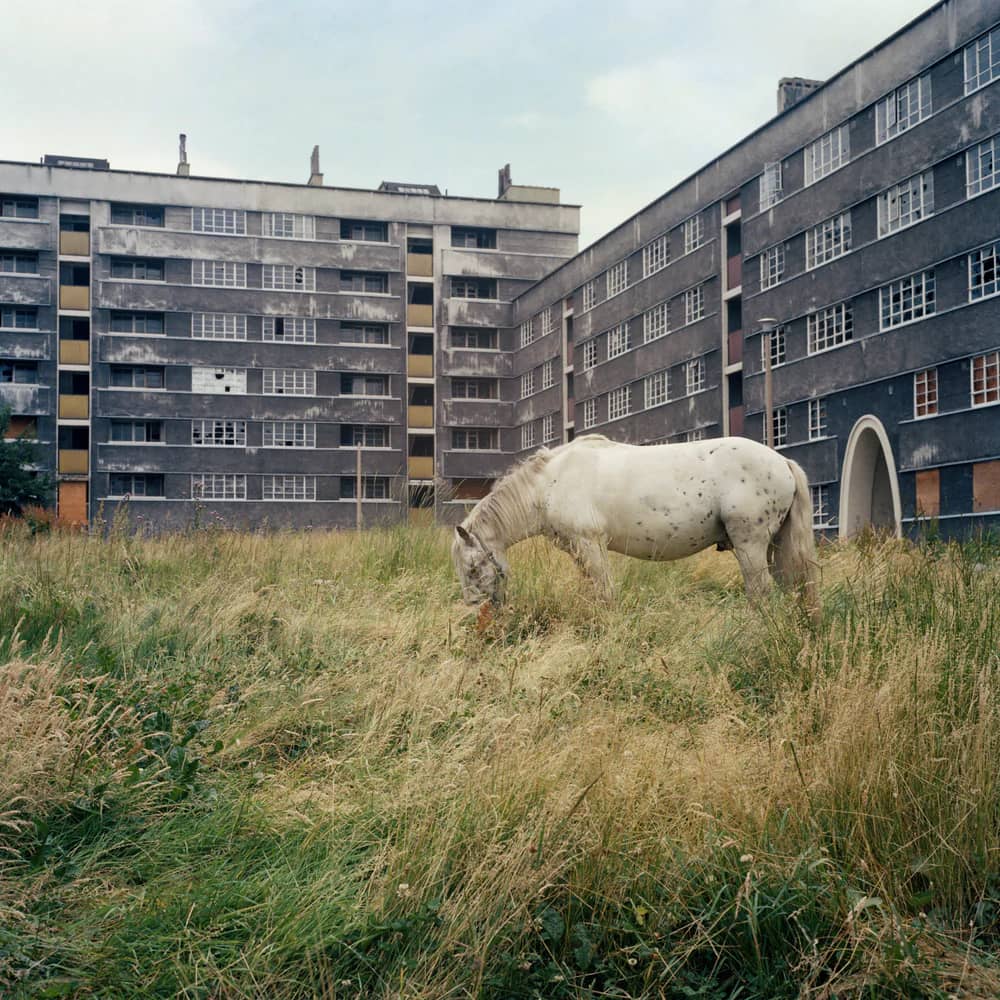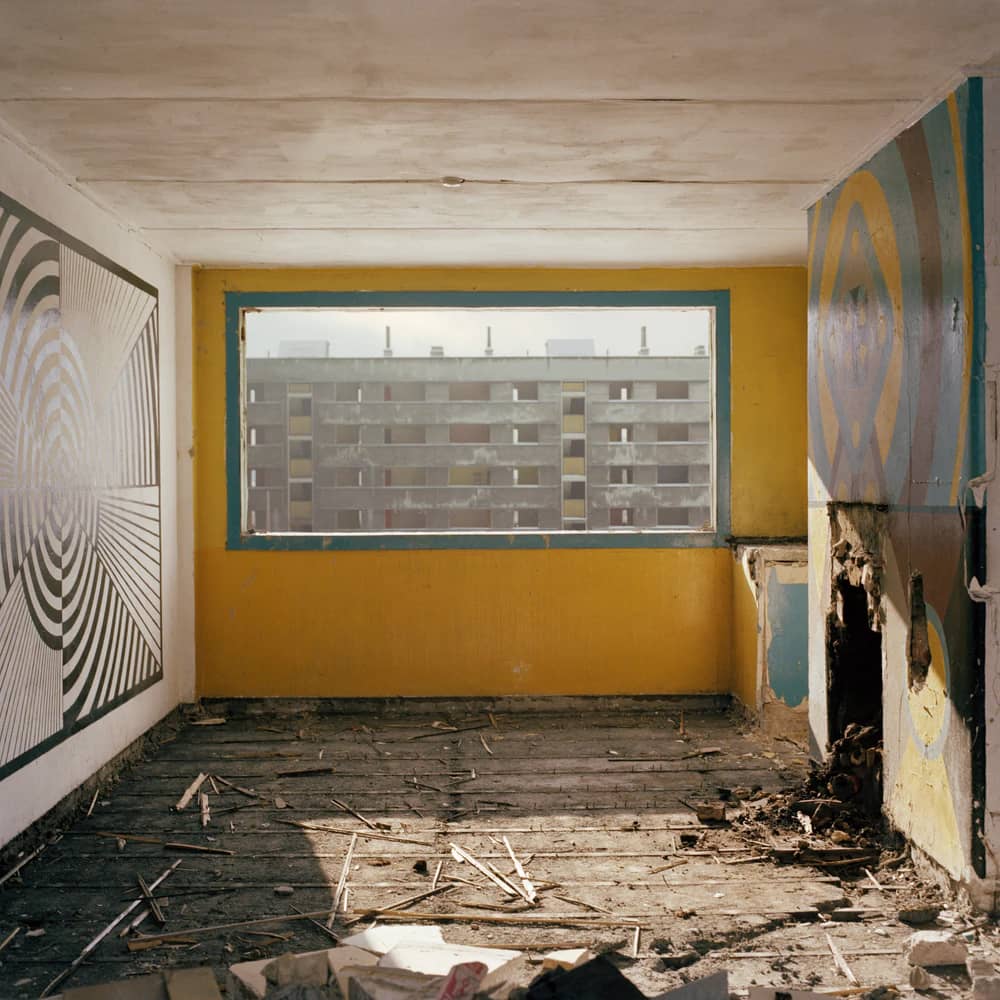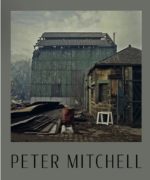Les premières copies contiennent un C-Print signé de 12,5×12,5cm (image du cheval)
“I photograph dying buildings and Quarry Hill was terminal by the time I got to it. Times change and I know there was no point in keeping Quarry Hill Flats. But what it stood for might have been worth keeping” – Peter Mitchell
Le livre fait suite à sa publication de 1990, Memento Mori, qui documente l’impact dramatique du projet de réaménagement de Quarry Hill à Leeds.
Le livre contient plus de 40 nouvelles images, documentant l’abandon et la démolition subséquente du site, ajoutant un chapitre final poignant à la publication de 1990 et son édition en fac-similé ultérieure. Évitant en grande partie le matériel d’archives vu dans Memento Mori, Epilogue adopte une approche plus narrative pour raconter cette dernière partie de l’histoire. Mitchell est à nouveau le seul vagabond dans un paysage de plus en plus impopulaire et autre-mot.
Quarry Hill était un grand lotissement à Leeds construit dans les années 1930 dans le cadre d’une « grande expérience sociale » pour accueillir une communauté entière de 3000 personnes. Dans les années 1970, la vision et les appartements étaient en ruine et la décision a été prise de démolir.
Bien que la notion d’utopie sous-tend le récit de Quarry Hill, de ses débuts passionnément visionnaires à son déclin progressif et sa fin finale, il n’y a pas de morale réelle ou de conclusions faciles à tirer. Comme l’a écrit Bernard Crick, c’était « de petites choses, et non une faute inhérente au grand dessein qui a détruit Quarry Hill ». Il était plus sur les timings que toute autre chose – une triste fin. Les chroniques et photographies de Peter Mitchell montrent simplement ce qui arrive aux utopies lorsqu’elles implosent.
Peter est un brillant chroniqueur de la vie : pas seulement comme photographe, mais comme historien social et conteur. Quarry Hill lui a fourni les ingrédients parfaits. Il a combiné des documents originaux, des photographies d’archives, l’histoire orale, ses propres observations sur les utopies et ses photographies dans ce qui est devenu une recette classique de la façon d’utiliser différents aspects pour illustrer les complexités du changement et de l’échec.
Dans les murs de la bourse de photographie il y a une interprétation standard du travail de Peter comme « charmant », mieux mis par Martin Parr dans son introduction à Étrangement familier (2013) « Le charme de l’œuvre de Mitchell est incarné par des images de magasins et d’usines dont les propriétaires ou la main-d’œuvre se tiennent fièrement devant leurs entreprises. » Le travail de Peter sur Quarry Hill non seulement s’en écarte, mais démolit cette interprétation particulière de ses réalisations. Peter lui-même est en effet le photographe le plus charmant et le plus humble, mais ses photos de Quarry Hill sont tout sauf charmantes, et elles montrent un aspect beaucoup plus sérieux et l’intention au travail.
Le livre est le dernier résultat du travail de RRB avec Mitchell pour préserver ses archives, dont une grande partie reste inédite. Sélectionné et séquencé par Rudi Thoemmes et Josie Atkinson de RRB, le livre est représentatif d’une relation de travail de dix ans, incluant des images de renom et des favoris personnels. Toutes les images ont été soigneusement numérisées, restaurées et imprimées selon les exigences élevées de Mitchell, et présentées dans le style de conception classique de RRB.
The 1st copies have with a 5×5″ signed c-print (horse image)
The book acts as a sequel to his 1990 publication Memento Mori, which documented the dramatic impact of the Quarry Hill redevelopment project in Leeds.
The book contains over 40 new images, documenting the abandonment and subsequent demolition of the site, adding a poignant final chapter to the 1990 publication and its later facsimile edition. Largely eschewing the archive material seen in Memento Mori, Epilogue takes a more narrative approach to telling this final part of the story. Mitchell is again the lone wanderer in an increasingly unpopulated and other-wordly landscape.
Quarry Hill was a large housing estate in Leeds built in the 1930’s as part of a ‘great social experiment’ to accommodate an entire community of 3000 people. By the 1970’s both the vision and the flats were crumbling and the decision was made to demolish.
Though the notion of Utopia underpins the narrative of Quarry Hill, from its passionately visionary beginnings to its step-by-step decline and final end, there are no real morals or easy conclusions to be drawn. As Bernard Crick wrote, it was “small things, not any inherent fault in the grand design, which destroyed Quarry Hill.” It was more about timings than anything else – a sad ending. Peter Mitchell’s chronicles and photographs simply show what happens to utopias when they implode.
Peter is quite a brilliant chronicler of life: not just as a photographer but as a social historian and storyteller. Quarry Hill provided him with the perfect ingredients. He combined original documents, archival photographs, oral history, his own observations on utopias and his photographs into what has become a classic recipe of how to use different aspects to illustrate the complexities of change and failure.
Within the walls of photography scholarship there is a standard interpretation of Peter’s work as “charming”, best put by Martin Parr in his introduction to Strangely Familiar (2013) “The full charm of Mitchell’s work is embodied in images of shops and factories with owners or work force standing proudly in front of their businesses”. Peter’s work about Quarry Hill not only deviates from this but demolishes that particular interpretation of his achievements. Peter himself is indeed the most charming and humble photographer, but his pictures of Quarry Hill are anything but charming, and they show a much more serious aspect and intent at work.
The book is the latest result of RRB’s work with Mitchell to preserve his archive, much of which remains unpublished. Selected and sequenced by RRB’s Rudi Thoemmes and Josie Atkinson, the book is representative of a decade-long working relationship, including both well-renowned images and personal favourites. All of the images have been expertly scanned and restored and printed to the high standard Mitchell’s work demands, and presented in RRB’s classic design style.













